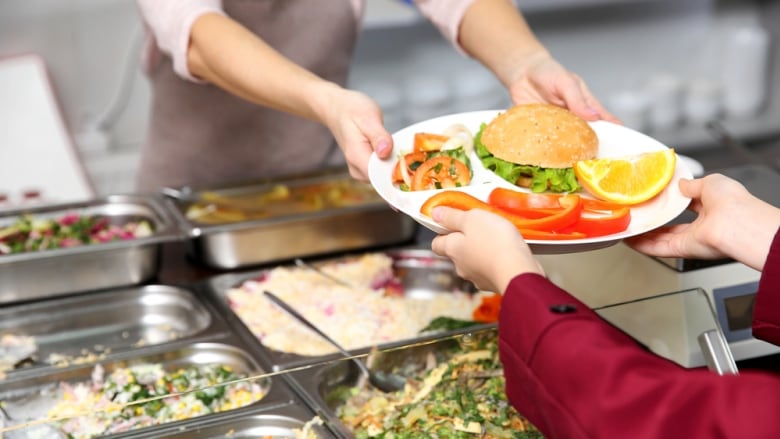School meal programs struggle to serve growing number of students in need as food prices climb
As food prices in Canada continue to soar, putting pressure on families as they buy groceries, pay the rent and try to make ends meet, school nutrition programs across the country say they’re struggling to provide meals to a growing number of students in need.
The Breakfast Club of Canada, one national program that reaches more than 580,000 children, says in the meal programs it supports in more than 3,500 schools, an average of 30 to 40 per cent of students typically participated prior to the pandemic.
With food prices remaining stubbornly high, now “some averages are closer to 60 and 75 per cent of the whole school population,” Judith Barry, co-founder of the breakfast organization, said in Montreal.
Grocery prices have an impact on school nutrition programs, since operators “can’t get the same value and the same amount of food” they need, said Barry, who is also the group’s director of government relations.
Some are forced to make tough choices, such as reducing the food items they’re offering or how often a program can run.
After weathering nearly three tumultuous years of adapting to restrictions and lockdowns during the COVID-19 pandemic, school nutrition programs across the country are now struggling with another crisis: ever-rising food costs coupled with a surge in the number of students who need a daily meal.
For program operators, an anticipated national school food program pledged by the federal government can’t come soon enough.
‘School food is an essential service’
“All over the world, people know that kids can’t learn unless they are well fed,” said Debbie Field, co-ordinator of the Coalition for Healthy School Food, a national group of non-profit organizations working to increase student access to nutritious school meals.
“School food is an essential service.”
Field, who is also an associate member of the Centre for Studies in Food Security at Toronto Metropolitan University, noted that when in-person classes closed down at different points earlier in the pandemic, it underlined just how important school breakfast, lunch and snack programs are for many students.

Debbie Field, co-ordinator of the Coalition for Healthy School Food, says when in-person classes closed down at different points earlier in the pandemic, it underlined just how important school breakfast, lunch and snack programs are for many students. (Doug Husby/CBC)
Although provincial, territorial and some municipal governments have helped fund school nutrition programs, and Canada has “a lot of creative people running food programs across the country,” Field said the system needs more.
“As the food prices go up, core funding to school food programs needs to be increased,” she said.

The Angel Foundation for Learning helps fund student nutrition programs in Toronto schools. The charity provides support to more than 180 student nutrition programs, which feed 61,000 students each school day. (Evan Mitsui/CBC)
In Toronto, John Yan, executive director of the Angel Foundation for Learning, has been busy with ongoing fundraising discussions and new initiatives in hopes of boosting the support the charity provides to more than 180 student nutrition programs, which feed 61,000 students each school day.
The foundation collects financial contributions from a variety of sources, including levels of governments, private donors and fundraising campaigns with corporate partners — such as grocery retailers running the forthcoming Toonies for Tummies appeal — and turns over that funding to in-school programs.
Some schools have seen participants in food programs double, Yan said, and since these operations focus on fresh, healthy offerings and are required to follow specific nutritional guidelines, staff may have no choice but to pay higher food prices.
“In many of the schools … that single snack or meal may be the only nutritious food that student or child gets that day,” he said.

John Yan, executive director of the Angel Foundation for Learning, says the group released emergency funds to 12 school food programs last week. Before the pandemic, such top-up funding requests were typically made near the end of the school year. (CBC)
Last week, the foundation released $60,000 in emergency funds to 12 school food programs in the city. Before the pandemic, Yan said, top-up funding requests typically arrived close to the end of the school year.
“If we’re already topping up emergency funds in January, I can’t imagine what it’s going to be like when we hit May and June.”
Need is growing, principal says
Whether welcoming new families or helping serve pizza subs at lunch, Edmonton principal Maureen Matthews sees first-hand the increased need for the free snack-and-lunch program at Norwood School, a public school near the city’s downtown.
“Last year, we had just over 180 students accessing our school nutrition program, and this year we’re well over 220,” she said.

Maureen Matthews, principal of Norwood School in Edmonton, reads the weekly snack and lunch menu. The school partners with non-profit organization E4C to provide students with nutritious food on a take-what-you-need basis. (CBC)
There’s also been a rise in “families who — when they come in to register their students with us — ask about whether or not we have a lunch program,” Matthews said. “I see first-hand the relief on their faces when I say, ‘You know what? We do offer that.'”
Norwood’s program, offered through the support of Edmonton-based non-profit charitable organization E4C, operates on a “take what you need” model. On one day, 225 students might be accessing food; on the next, it might be 200 students needing a snack, lunch or both.
“We don’t want to stigmatize people who are experiencing food insecurity. Food is a basic right, and it’s essential to children’s success,” said Kelly Bickford, E4C’s manager of community and school-based programs.
“If [students] need just some fruits or vegetables because their family can’t afford to buy those, they can access that. Or if they need to access the whole meal, they can do that…. We just build that capacity and understanding with [the students] to know that when and if they need it, they can access it in the way that they need.”
Kelly Bickford, E4C’s manager of community and school based programs, says food ‘is a basic right, and it’s essential to children’s success.’ (Samuel Martin/CBC)
Searching for more revenue sources
In Newfoundland and Labrador, the School Lunch Association, based in St. John’s, has expanded this month to serving more than 7,000 nutritious midday meals every school day. It’s boosted service to 41 locations — with more seeking to join — under its pay-what-you-can model (with a modest suggested price of $4 per lunch).
Yet while more students are signing up for lunch, the group is also seeing a rise in the proportion of participants

Students in Newfoundland and Labrador enjoy a special cod lunch organized by the School Lunch Association in November. The association has expanded this month to serving more than 7,000 midday meals every school day. It’s also boosted service to 41 locations under its pay-what-you-can model. (Jeremy Eaton/CBC)220,” she said.
unable to pay for it, according to executive director John Finn.
“There’s a lot of parents who reach out … and they’ll send a personal email that says: ‘Hey I don’t get paid until next week. I’ll contribute when I can’ or ‘I just lost my job and times are tough. I normally pay the full amount,'” he said.
Before the pandemic, about 90 per cent of the revenue the association needs to operate came from sales, with the rest covered by donations and a provincial grant.
This school year, sales are representing 78 to 80 per cent, leaving a gap in funds at the same time that the association has seen food and supply cost increases of 11 per cent and 17 per cent, respectively. This comes after food costs had already risen 20 per cent, and supply costs were up 25 per cent, over the 2021-22 school year.
“It’s a bit of a double-edged sword,” Finn said. Enrolment is up, but it comes as “we’re absorbing additional food costs and supply costs and then, on the opposite side, we’re actually seeing a decrease in the amount of revenue we would normally achieve [from families paying].”

In addition to working to bring down operational costs and looking for new revenue sources, John Finn, executive director of the School Lunch Association, says he hopes to see movement on a national school food program in this year’s federal budget. (Jeremy Eaton/CBC)
Recent efforts to pare down the association’s operational costs include slight tweaks to menu items, finding new vendors and more price negotiating with existing ones.
Staff are exploring additional revenue sources: new donors, further government grants or perhaps a charitable lottery licence. Finn said he also hopes to see movement on a national school food program in this year’s federal budget — as are his school nutrition peers across Canada.
Recent consultations on national program
“We have a patchwork of programs supported by individuals, the private and community sector, and that is great … but we need more as well,” said Breakfast Club co-founder Barry.
“A national school food policy would help us really build on what exists — the existing ecosystem — and would help us reach more students and more communities.”
More than 5,000 participants — program organizers, parents, volunteers, teachers and more — joined consultations on a national school food program that wrapped up in December, said Karina Gould, the federal minister of families, children and social development, who was tasked with investigating a program alongside Agriculture Minister Marie-Claude Bibeau.
A report gathering the information is next, with an eye to developing a program “that will work right across the country, responding to the unique needs in each province and territory,” Gould told CBC News, adding that it must also be presented to her colleagues in Ottawa.
Gould said she sees this as a natural followup to the daycare program adopted across Canada last year and believes the success of that recent partnership can spark confidence for similar joint efforts across governments.
“I really see school food as an additional pillar to make sure that we’re setting up all of our children for success in Canada.”









Redes Sociais - Comentários